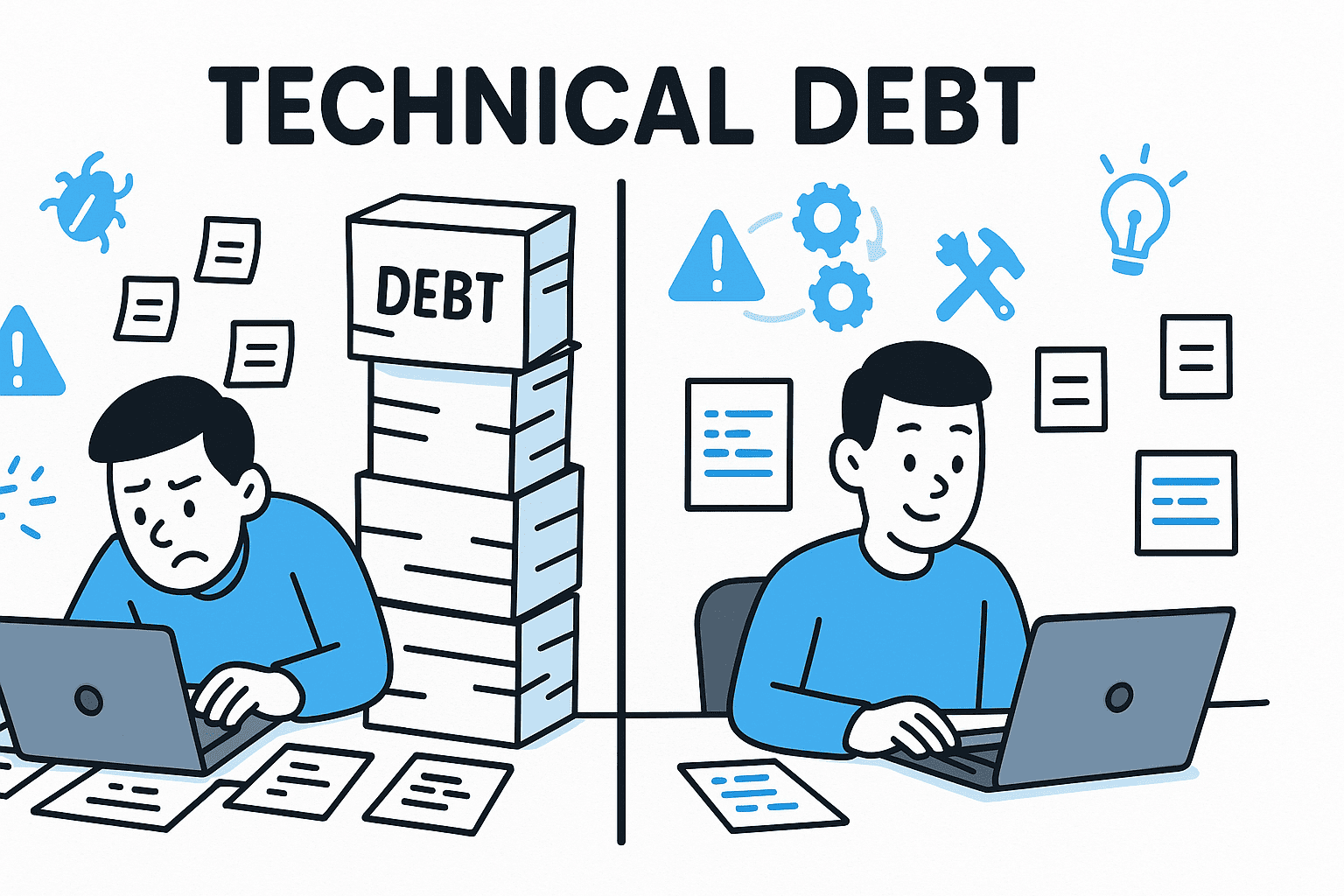In today’s fast-paced digital world, businesses and developers often prioritize speed and delivery over long-term code quality. While this approach helps get products to market faster, it can create hidden challenges down the road. This challenge is commonly referred to as technical debt.
In this article, we’ll break down what technical debt is, why it matters, and how to manage it effectively, whether you’re a startup founder, CTO, or software engineer.
What is Technical Debt?
Technical debt (also known as code debt) refers to the future cost of reworking software that was built quickly but not optimally. It’s a metaphor borrowed from financial debt: just like monetary debt, you “borrow” time by cutting corners in code, but you must “repay” it later with extra effort to fix, refactor, or rebuild.
In simple terms:
- Technical debt = quick, short-term coding solutions today.
- Repayment = fixing inefficiencies, bugs, or scalability issues tomorrow.
Common Causes of Technical Debt
Technical debt isn’t always bad, it often results from business needs. But understanding the root causes helps reduce unnecessary burdens:
- Rushed Deadlines: Shipping features fast to meet market demands or investor expectations.
- Lack of Documentation: Poorly documented systems make future changes harder.
- Outdated Technology: Using legacy frameworks, libraries, or infrastructure that no longer scale.
- Poor Code Quality: Quick fixes, copy-paste coding, or ignoring clean architecture principles.
- Changing Requirements: Projects evolve, but the original code isn’t updated to match.
- Insufficient Testing: Skipping unit tests or automation to save time.
Types of Technical Debt
Not all technical debt is the same. Recognizing its type helps in managing it:
- Intentional Technical Debt: When developers knowingly take shortcuts for speed, planning to fix it later.
- Unintentional Technical Debt: Mistakes or lack of experience that cause inefficient code without realizing it.
- Environmental Technical Debt: Caused by changes in technology or business environments (e.g., APIs being deprecated).
Why Technical Debt Matters
Unchecked technical debt can create major challenges for businesses and teams:
- Slower Development: Every new feature takes longer to build due to messy code.
- Higher Costs: Refactoring later is usually more expensive than doing it right the first time.
- Security Risks: Quick fixes may introduce vulnerabilities.
- Team Burnout: Developers spend more time fixing bugs than innovating.
- Customer Dissatisfaction: Bugs and performance issues directly impact user experience.
How to Manage and Reduce Technical Debt
While it’s impossible to eliminate technical debt completely, you can control it with these strategies:
- Prioritize Refactoring
- Dedicate regular sprint time to cleaning up code.
- Use automated tools to detect code smells and inefficiencies.
- Adopt Agile Practices
- Break down projects into smaller iterations.
- Constantly review, test, and refactor code.
- Write Clean, Documented Code
- Follow best practices and coding standards.
- Ensure documentation is clear for future developers.
- Automate Testing
- Implement CI/CD pipelines.
- Use unit, integration, and regression tests to catch issues early.
- Track Technical Debt Like Financial Debt
- Use metrics such as code coverage, cyclomatic complexity, or tools like SonarQube.
- Treat debt repayments as part of your backlog, not an afterthought.
- Balance Speed vs. Quality
- Sometimes, short-term debt is acceptable to win early market adoption.
- The key is knowing when to “pay it back.”
Technical Debt and AI Development
In the era of AI and LLM-powered applications, technical debt takes on new forms. Poorly designed data pipelines, unscalable model deployments, and lack of monitoring can lead to AI technical debt. If ignored, this can:
- Inflate costs of training and inference.
- Reduce model accuracy over time.
- Create compliance and ethical risks with biased or unverified data.
Forward-thinking teams now treat data and AI system debt as equally important as traditional code debt.
Final Thoughts
Technical debt isn’t inherently bad, it’s a strategic trade-off. The real danger lies in ignoring it. Businesses and developers who recognize, track, and manage technical debt proactively will:
- Deliver faster without sacrificing long-term quality.
- Keep systems scalable, secure, and adaptable.
- Maintain happier teams and more satisfied customers.
By balancing speed with sustainability, you turn technical debt from a hidden burden into a manageable investment.
🤝 Need a Custom RSVP System or Dashboard?
I help businesses build tools that actually work , even on tight deadlines.
Whether you're planning an event, need internal tools, or want a custom dashboard for your team , I can help.
Reach out
📧 Email: safi.abdulkader@gmail.com | 💻 LinkedIn: @abdulkader-safi | 📱 Instagram: @abdulkader.safi | 🏢 DSRPT
Drop me a line, I’m always happy to collaborate! 🚀



